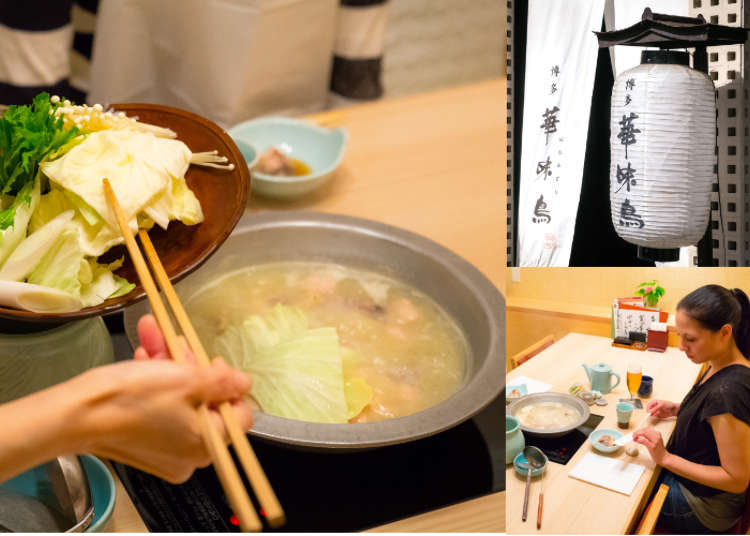
Chicken Nabe Hot Pot in Ginza: Enjoying Traditional Japanese Winter Soul Food! (Video)
- Written by: Holly Neslusan
As the weather cools, there’s one dish that everyone in Japan looks forward to getting a taste of: nabe, otherwise known as the Japanese-style hotpot. LIVE JAPAN took a visit to Hanamidori in Ginza to try one of the best restaurants for the type of nabe called mizutaki.
What is Nabe? How is Mizutaki Different?

There are many kinds of hot pot dishes in Japan. You can find a number of variations on the cold weather dish, with ingredients such as fish, scallops, meat, mushrooms, leafy greens, and more, depending on the type, region, or personal preference. Nabe is often thought of as typical home-cooked type of meal. There’s nothing quite like gathering around a hot pot shared with family and friends in the comfort of one’s home. However, even if you are only visiting Japan, you can still experience a traditional hot pot meal!
I’m no stranger to nabe; I’ve tasted quite a few, and enjoy trying to cook my own version at home. Does this mean I’ve tasted them all? Certainly not! Always in search of a new food discovery, there was one particular type of nabe I was curious to try: mizutaki. Mizutaki is a type of chicken hot pot originating from Fukuoka Prefecture. Besides the main ingredient of chicken, what makes mizutaki quite unique is that a specific method of eating has been developed to maximize the tasting experience.
Eating Authentic Mizutaki at Hanamidori
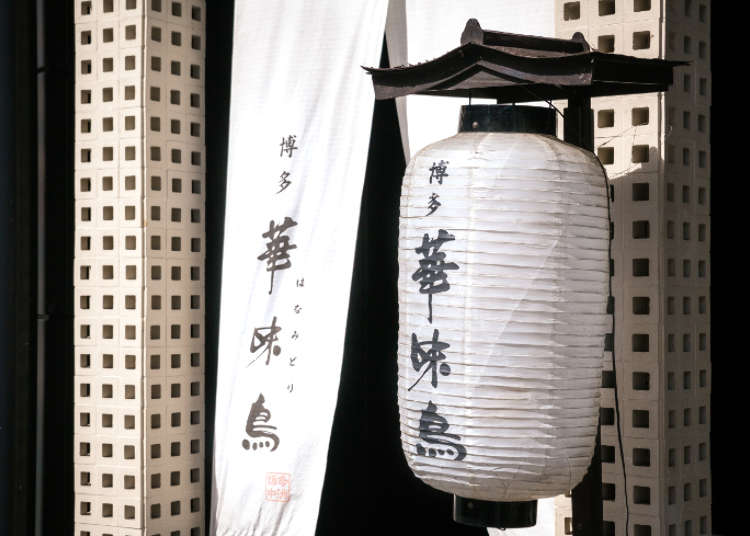
Mizutaki is a specialty of Fukuoka, so finding this type of nabe outside of Kyushu can be a bit of a challenge. Luckily, Hanamidori, one of Hakata, Fukuoka’s best restaurants for mizutaki, has branches across Japan, as well as in Taiwan, China, and Singapore. My friend Kaori and I visited the Hanamidori in Ginza, but there are in fact, several other Hanamidori locations throughout Tokyo.
The restaurant itself has a traditional sophistication about it, but still has a comfortable atmosphere, so we could easily relax throughout our meal and make ourselves ‘at home’ to a certain extent. An English menu is available, so even customers without the slightest knowledge of Japanese can order without concern.
Preparation and an Exquisite Broth
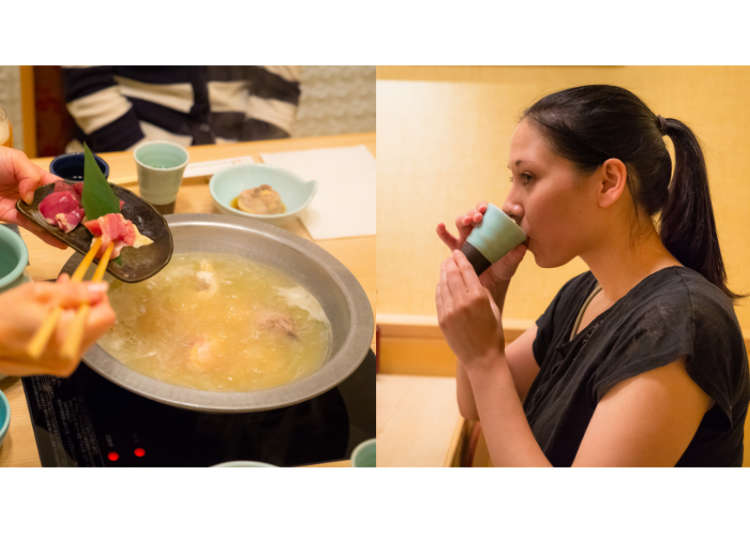
Kaori and I ordered the “Hanamidori Mizutaki Aji Course.”(The price is 4,200 yen per person. A minimum of two people are required.) This is the base nabe of the shop. For those who are feeling especially hungry, course meals are an option, as well as additional items. To begin, our hostess for the meal placed a shallow pot on top of the electric burner located in the center of our table, into which, a light,salty broth made from a chicken-based stock was poured. As the liquid began heating up, large pieces of chicken leg meat were placed in the pot. We sipped drinks and waited for the first taste as the savory aroma of the nabe began to fill the room. After a few minutes, the froth floating on the top of the liquid was skimmed out, and the broth was poured into two soup cups. While this smooth soup appeared to be simple, its flavor was intense and flavorful. It’s worth noting that unlike other kinds of soup, this is meant to be sipped straight from the cup, rather than ladled from a spoon.
The First Taste of Savory Chicken
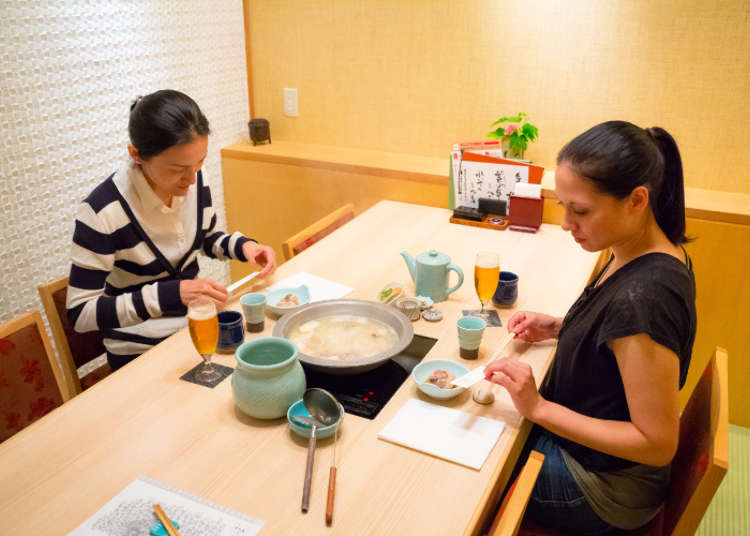
I still had not finished the soup before my first piece of chicken was ready to be savored. The chicken legs were placed into bowls with a small amount of ponzu, which is a tart, citrus-based sauce. Before I took my first bite of the juicy meat, I took full advantage of the optional toppings on the table: a generous helping of chopped scallions, and a dab of the spicy-citrusy yuzu-kosho (a paste made from chili peppers and the Japanese yuzu fruit) completed my chicken preparations.
While it was a bit tricky to pick up such a large piece of meat without the aid of a fork and knife, the chicken looked so delectable that nothing was going to get in my way! The meat was tender and delicious. Once we had eaten all of the meat, we put the bones in the provided pot. But there was still more to come…
Even More Mizutaki
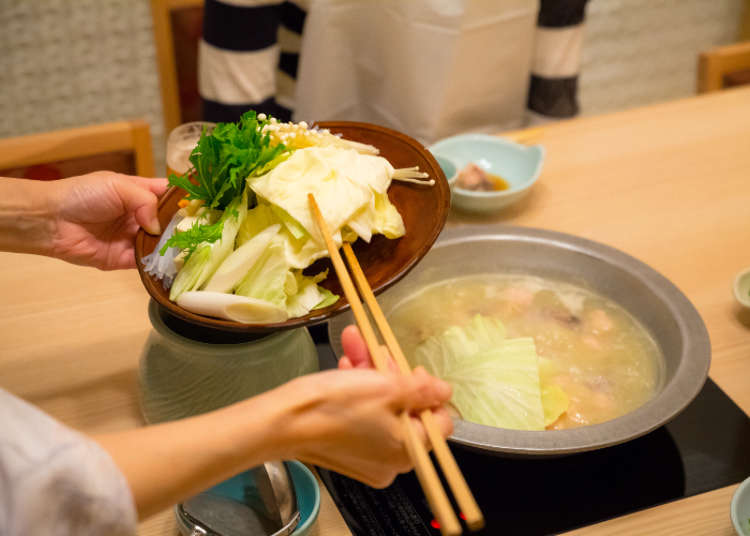
Now that our tastebuds were properly warmed up, it was time to move on to the next stage! The next ingredients added to the pot were chicken thighs, liver, and minchi. The minchi, which are basically meatballs, were made right before our eyes, as a minced chicken meat and egg mixture were formed into perfectly formed balls and put into the nabe. Next was an item you’re not likely to find in a Western-style hot pot: collagen. Collagen has become a very popular ingredient in Japan due to its reported beauty benefits, and it thickened the nabe quite nicely. A plate full of vegetables was also carefully placed among the other ingredients. This included carrot, cabbage, mizuna (a type of Japanese mustard), enoki mushrooms, leeks, and also kuzukiri, a long starchy noodle-like food made from the root of the kudzu plant.
Noodles and Pickles
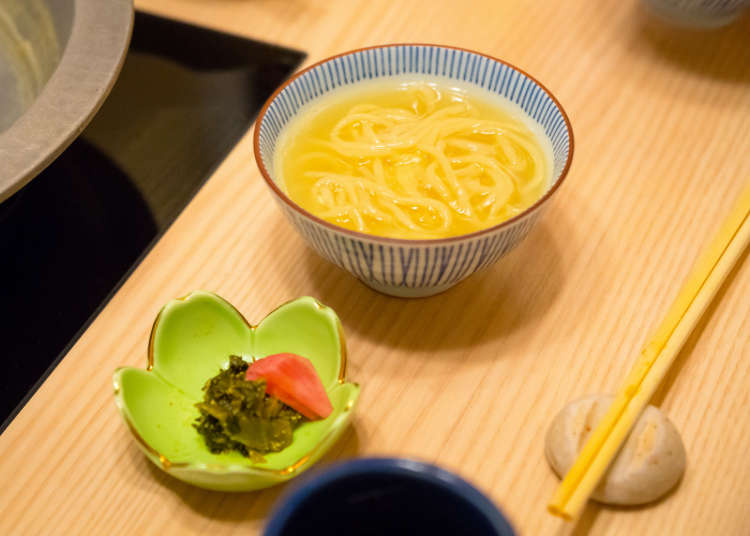
Once we had eaten all of the ingredients that had been cooked in the pot, it was time for the final act! Any leftover bits and pieces were skimmed from the broth, leaving nothing but liquid. We were given a choice of rice or noodles to add to the remaining broth. The resulting dish is either zosui or chanpon (a Nagasaki dish of ramen noodles boiled in broth), depending on which you choose to eat. We decided on chanpon, so noodles were added accordingly and cooked for a short period of time before we divided it up and slurped up the hot aOnce we had eaten all of the ingredients that had been cooked in the pot, it was time for the final act! Any leftover bits and pieces were skimmed from the broth, leaving nothing but liquid. We were given a choice of rice or noodles to add to the remaining broth. The resulting dish is either zosui or chanpon (a Nagasaki dish of ramen noodles boiled in broth), depending on which you choose to eat. We decided on chanpon, so noodles were added accordingly and cooked for a short period of time before we divided it up and slurped up the hot and tasty noodles. This final dish was served with a side of pickled vegetables called tsukemono. The crunchy taste of the tsukemono perfectly complemented the warmth of the final stage of mizutaki.
Goodbye Hanamidori
We finished the last of the hot pot, and said our goodbyes to the staff, any hunger fully satiated by this point. While sushi and ramen may be more well-known foods from Japan, if you want to try a true homestyle meal from Japan, you really need to get a taste of nabe, and if you have the chance, I highly recommend mizutake!
TEL: 03-3547-3211
Access: Ginza Station (Ginza Line, Marunouchi Line), 3 minutes on foot.
Hours: 11:30 a.m. - 3:00 p.m., 5:00 p.m. - 11:00 p.m.
Holidays: None
-
Mizutakiryotei Hakatahanamidori Ginza4choumeten水炊き料亭 博多華味鳥 銀座四丁目店
- Address B1 4 Chome Tower, 4−9−13 Ginza, Chuo, Tokyo104-0061
After growing up in Massachusetts, Holly headed to Japan in search of new adventures and green tea. She ultimately made her way to Tokyo, where she enjoyed exploring and writing.
- Area
- Category
*Prices and options mentioned are subject to change.
*Unless stated otherwise, all prices include tax.
Popular Tours & Activitiess
-

Jujutsu Kaisen Takes Over JR East With a Wrapped Shinkansen This Winter
by: Guest Contributor
-

Japan’s Shinkansen Is About to Change Travel in an Unexpected Way
by: Guest Contributor
-
Ad

(Opening in Jan 2026) 'THE SUMO LIVE RESTAURANT HIRAKUZA GINZA TOKYO!' 5 Exciting Ways to Experience the World of Sumo!
-

Strawberries, Style, and Tokyo’s Coolest Neighborhood: Winter Afternoon Tea in Kichijoji
by: Guest Contributor
-
Ad

Complete Guide to Ueno's National Museum of Nature and Science, the Perfect Place to Visit on Rainy Days or With Children
-

This Winter, Godzilla Takes Over Haneda Airport
by: Guest Contributor
Inspiration for Accommodations
-

Enjoy Mt. Fuji from the Comfort of Your Room! Recommended Ryokan with Mt. Fuji View
-

Stay Near the Cherry Blossoms! Hotels for Cherry Blossom Viewing in Tokyo
-

Family-Friendly Hotels with Free Shuttle to Disneyland: Convenient Access for a Magical Stay
-

Top Ranked Hakone Hotels with Mt. Fuji View: Enjoy Stunning Scenery from Your Private Space
-

Convenient Tokyo Hotels with Airport Shuttle: Ideal for Families and Heavy Luggage
-

Stunning Tokyo Tower View Hotels: Enjoy Spectacular Scenery from Your Private Space
-

Convenient Asakusa Hotels with Kitchens: Ideal for Extended Family Visits
-

Experience Luxury: Hakone's 10 Best Five-Star Accommodations
-

Enjoy Mt. Fuji Autumn Leaves! Top Hotels Near the Popular Autumn Leaves Corridor
-

Experience Hakone Fall Foliage from Your Room with Stunning Views
-

Exploring Tokyo: 4 Must-Visit Spots around Tokyo Station
-

Shibuya Food Tour: Enjoy a Hearty Dinner at These 3 Warm and Inviting Izakaya in Shibuya
-

Bunka Hostel Tokyo - Inside the Charming Izakaya Pub With a Quirky Twist!
-

Late Dinner in Asakusa: 3 Spots Open Late Near Sensoji Temple
-

Secrets to Shopping in Japan: Guide to Annual Sales in Japan & Where to Shop
by: Miyu Shimada
-

Ueno Station Area Guide: Fun Ways to Explore Tokyo's Popular Destination (Area Map & Sightseeing Tips)
- #best ramen tokyo
- #what to buy in ameyoko
- #what to bring to japan
- #new years in tokyo
- #best izakaya shinjuku
- #things to do tokyo
- #japanese nail trends
- #what to do in odaiba
- #onsen tattoo friendly tokyo
- #daiso
- #best sushi ginza
- #japanese convenience store snacks
- #best yakiniku shibuya
- #japanese fashion culture
- #best japanese soft drinks




















